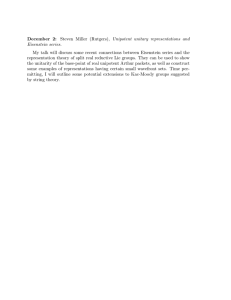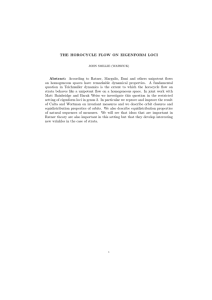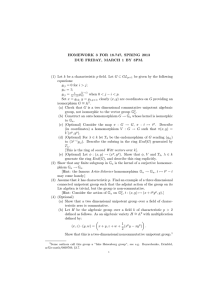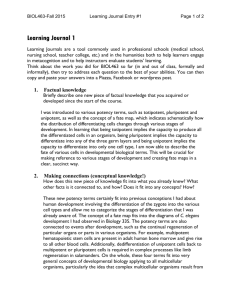Motives and Diophantine geometry IV July 6, 2006 1
advertisement
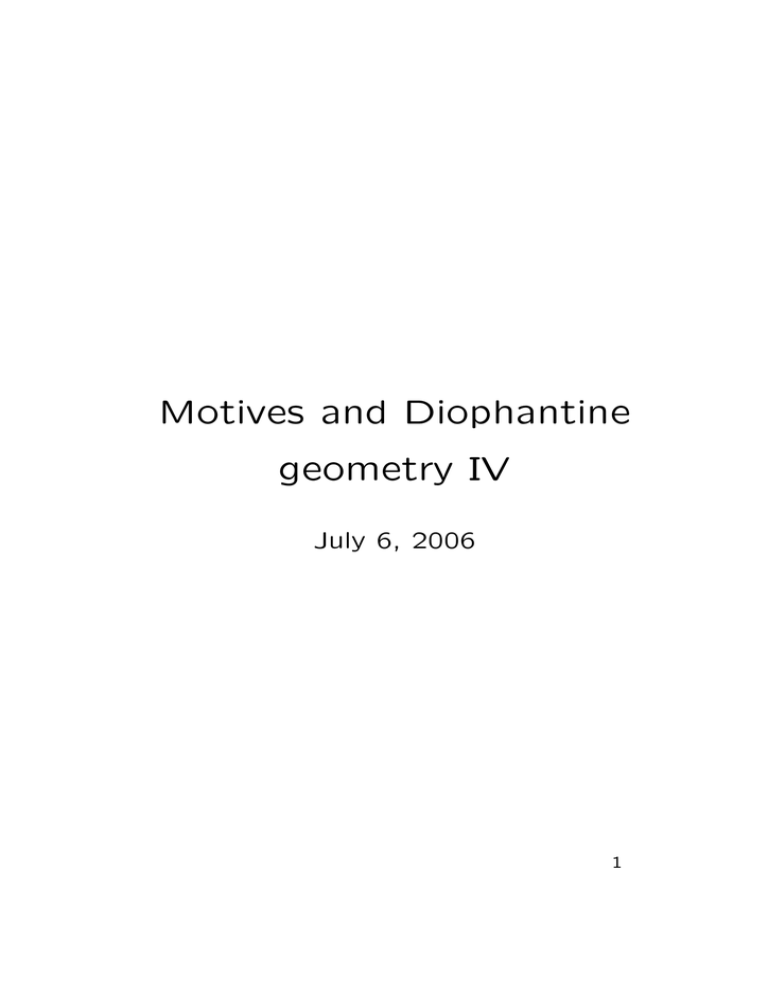
Motives and Diophantine
geometry IV
July 6, 2006
1
Today: Some constructions and one example.
2
Theory of motives (Q-homological) admits
many techniques, but looses much information.
Anabelian geometry (pro-finite) is expected
to completely encode certain schemes, but
allows far fewer techniques.
π̂1 → · · · very far · · · → H1
3
π̂1 → · · · →motivic π1 → H1
Motivic π1 is still quite close to homology,
and hence, admits homological techniques.
But non-abelian!
4
Review of topological situation. X topological space. π1(X, b) is a discrete group.
H1(X, Q) is a vector space, hence, an algebraic group. Relation between the two has
to do with certain completions.
For any discrete group G (finitely generated), various ways of turning it into an algebraic group. Easiest one to describe is the
unipotent completion U (G) w.r.t. a field F
of characteristic zero.
5
Start with the group ring F [G], has the natural structure of a Hopf algebra:
∆ : F [G]→F [G] ⊗ F [G]
defined by
Σg cg [g] 7→ Σg cg g ⊗ g
In fact, easy to show that G is recovered
exactly as the group-like elements of F [G]:
{a ∈ F [G]|∆(a) = a ⊗ a}
6
Let I be the augmentation ideal defined by
the exact sequence
deg
0→I→F [G] → F →0
and define the completed group algebra
n
R := ←
lim
F
[G]/I
−
Any finite-dimensional F -rational representation
ρ : G→Aut(V )
extends to
ρ : F [G]→End(V )
This extends to
ρ : R→End(V )
iff the original representation is unipotent.
7
The comultiplication ∆ extends to one on
R, and we define the F −unipotent completion UF (G) of G to be the group-like elements in R.
Its image in any of the quotients F [G]/I n is
a unipotent algebraic group over F , giving
U (G) the structure of a pro-unipotent, proalgebraic group.
8
When X is a space and G = π1(X, b), then
there is a functorial geometric approach to
the definition of U B (X) = UQ(π1(X, b)).
Consider
UnB (X)
the category of unipotent locally constant
sheaves of Q vector spaces on X. Can consider this as a Q-linearized version of the
category of covering spaces. Associated to
points, there are fiber functors
fb : UnB (X)→VectQ
9
Fact:
U B (X) ' Aut⊗(fb)
Then this allows us to construct ‘unipotent
completions of path spaces’ as
P b(X, x) := Isom(fb, fx)
Pro-algebraic variety.
10
When we start with the fundamental group
π1(X, b) of a manifold X, we can construct
B (X) = U (π ) using differential forms,
UC
C 1
i.e., Chen’s iterated integrals.
11
Given n complex 1-forms αi on X, get a
function [a1|a2| · · · |αn] on paths as follows.
If γ : I→X is a piecewise smooth paths,
write γ(αi) = fi(ti)dti. Then
[a1|a2| · · · |αn](γ) =
Z 1
0
f1(t1)
Z t
1
0
f2(t2)
Z t
2
0
···
Z t
n−1
0
fn(tn)dtndtn−1 · · · dt1
Subject to a certain algebraic condition, such
functions are homotopy invariant, linear combinations of these naturally form a Hopf algebra II(X) of iterated integrals.
12
Fact:
UC(π1(X, b)) ' Spec(II(X))
Another formulation: If A is the coordinate
B (π ), then A ⊗ C ' II(X). Usring of UQ
1
ing this, can put natural Q-Hodge structure
on A. Actually need to do this carefully to
encode dependence on basepoint, but will
ignore this subtlety here. The Hodge filtration F iA ⊂ A is by ideals that are compatible
with the comultiplication, and hence, define
subgroups
B = Z(F 1−i)
F iUC
In fact, get a Hodge structure on all P B (X, x),
which varies with the base-point x.
Will often omit X from notation and write,
e.g., P B (x).
13
When X is a smooth variety defined over
Q, can also define U DR (X), the De Rham
fundamental group of X, which is a prounipotent, pro-algebraic group over Q admitting a purely algebraic definition.
Uses the category
Un(X)
of unipotent vector bundles with flat connection.
That is, the objects are (V, ∇), vector bundles V on X equipped with flat connections
∇ : V→ΩX/S ⊗ V
that admit a filtration
V = Vn ⊃ Vn−1 ⊃ · · · ⊃ V1 ⊃ V0 = 0
by sub-bundles stabilized by the connection,
such that
r
(Vi+1/Vi, ∇) ' (OX
Qp
, d)
14
Associated to b ∈ X get
eb : Un(XQ)→VectQ
The De Rham fundamental group
U DR := π1,DR (XQ, b)
is the pro-unipotent pro-algebraic group that
represents
Aut⊗(eb)
(Tannaka dual) and the path space
P DR (x) := π1,DR (X; b, x)
represents
Isom⊗(eb, ex)
15
This construction commutes with base-change,
giving us an isomorphism
P B (x) ⊗ C ' P DR (x) ⊗ C
From this, one has a theory of non-abelian
unipotent periods, including, for example,
multiple zeta values: arises from taking the
torsor of paths on P1 \ {0, 1, ∞} going from
0 to 1 with tangential basepoints. Evaluate
Q-rational algebraic functions on P DR at the
point corresponding to the Q-rational point
of P B given by the standard path.
16
The pro-unipotent p-adic étale fundamental
group
U et
and étale path spaces
P et(x)
defined in the same way using the category
of unipotent Qp local systems.
Z i ⊂ U defined by descending central series.
Ui = Z i\U
Can push out torsors as well to get
Pi = Z i\P × U
17
Extra structures:
U et, P et: Γ-action.
U DR , P DR : Hodge filtrations and Frobeniusactions, coming from comparison with a crystalline fundamental group and crysalline torsors of paths.
18
Hf1(Γ, Unet)
Selmer varieties classifying torsors that satisfy natural local conditions. Most important one: Restriction to Gp trivializes over
Bcr .
U DR /F 0 classifies U DR -torsors with Frobenius action and Hodge filtration. Map
X(Q)→Hf1(Γ, Unet)
associates to a point the torsor Pnet(x). Similarly
X(Qp)→UnDR /F 0
uses torsor PnDR (x). Compatibility provided
by non-abelian p-adic comparison isomorphism.
19
Regard P et(x) just with local Galois action
of Γp. If P et(x) is its coordinate ring, then
(P et(x) ⊗ Bcr )Γp ' P DR (x)
the coordinate ring of P DR (x).
This construction explains the map
Hf1(Γ, Un)→UnDR /F 0
20
Finish today with a brief discussion of basepoint dependence, using the pro-finite case.
But first, start with topological situation.
X topological space. b, x ∈ X points. Cov(X),
category of covering spaces of X. fb, fx fiber
functors defined by the points.
Fact:
Isom(fb, fx) ' π1(X; b, x)
21
Proof: We have already discussed the map
π1(X; b, x)→Isom(fb, fx)
Let p : X 0→X be the universal covering space
of X. Choose a point b0 ∈ X 0 lying over
b ∈ X.
Injectivity: Consider action of γ and σ on
Xb0 . Then lifts γ 0 and σ 0 will take b0 to the
same point x0. But X 0 is simply connected,
so γ 0 and σ 0 are homotopic. So γ and σ are
homotopic.
Surjectivity: Let φ ∈ Isom(fb, fx) and put
x0 = φ(b0) ∈ Xx0 . Choose a path γ 0 and X 0
from b0 to x0 and let γ be its image in X.
Fact: Given any covering Y and c ∈ Yb, there
exists a unique map fc : X 0→Y such that
f (b0) = c.
So
γ(c) = γf (b0) = f (γ(b0)) = f (φ(b0)) = φf (b0) = φ(c)
22
Actually, note that we have an isomorphism
Isom(fb, fx) ' Xx0 (' π1(X; b, x))
Such that
φ ∈ Isom(fb, fx) 7→ φ(b0) ∈ Xx0
This fact generalizes!
23
E, elliptic curve over Q̄. We will describe
π̂1(E, 0)
and, more generally,
π̂1(E; 0, x)
Need to construct a ‘universal covering space.’
Suppose Y →E is an étale
Then Y has genus 1 and
ization
Y
%
d : E −→
cover of degree d.
we have a factor-
&
E
Denote by Ed this cover d : E→E.
Then the inverse system E 0 = {Ed} functions as a universal covering space. Note
that we have a choice of a lifting 00 = {Od} ∈
E00 .
24
Fact:
π̂1(E; 0, x) ' Ex0
Proof: Clearly have a map γ 7→ γ(00).
Injectivity: Let γ, σ ∈ π̂1(E; 0, x) satisfy γ(00) =
σ(00). Let c ∈ Y0 for a covering Y . Then
there is a map f : Ed→Y for some d. Furthermore, by translation, can make f (0d) =
c. An obvious argument gives us γ(c) =
σ(c).
Surjectivity: Left as an exercise.
25
This construction should make it clear that
the map
x 7→ [π̂(E; 0, x)]
is the same as that occurring in Kummer
theory.
Similar construction for any variety X. Can
construct a co-final system
X 0 = {Xi}
of finite Galois étale covers of X together
with a compatible system of base-points
b0 = {bi ∈ Xi}.
In this situation,
π̂1(X; b, x) ' Xx0
26
Similar in other situations: In De Rham setting, for example, can construct a universal
torsor
(P 0)DR
which is a principal U DR bundle with the
property that
DR (x).
(P 0)DR
=
P
x
27
Next time: sketch of argument involving
Diophantine finiteness.
28

